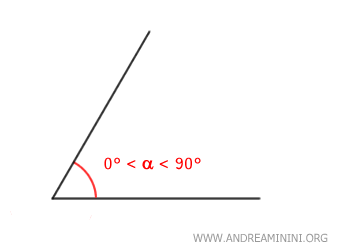Acute Angle
An acute angle is an angle that measures less than 90 degrees (π/2 radians).

In other words, it's an angle smaller than a right angle (90 degrees).
An acute angle "closes inward" rather than extending outward like an obtuse angle.
At first glance, an acute angle appears "closed."
Examples of acute angles include 30 degrees, 45 degrees, 60 degrees, and so on.
Notes
Here are some notes on acute angles:
- Convex Angles
Acute angles are a subset of convex angles because the extensions of their sides do not overlap. Therefore, while an acute angle is always convex, not all convex angles are acute. The set of convex angles includes acute, obtuse, and right angles. - Complementary Angles
Two acute angles are called "complementary angles" if their sum equals 90 degrees. In other words, two acute angles are complementary when their sum forms a right angle. For example, if one angle measures 30 degrees, its complementary angle will measure 60 degrees.
Acute angles frequently appear in many geometric figures and are particularly important in trigonometry, where they are used to calculate the relationships between the sides of a triangle.
